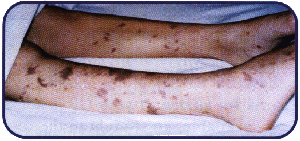
Hemophilus influenzae is one of several different bacteria that cause bacterial meningitis. Eighty percent of the bacterial meningitis in the United States is caused buy Hemophilus influenzae, Neisseria meningitis or Streptococcus pneumoniae. These bacteria are most of the time carried in the nasal passages or other places on the bodies of a small amount of healthy people, and can be spread from person to person through coughing and sneezing. There have been studies that show people are most easily infected with Hemophilus influenzae soon after getting over the flu. This is because of inflamed nasal tissues offer bacteria an easy entranceway into the body. Hemophilus influenzae causes a form of Meningitis that is an infection of the tissue, which covers the brain. In addition to meningitis, this bacterium can also cause blood stream infections, pneumonia, joint and bone infections and other infections. The Meningitis caused by Hemophilus influenzae is commonly referred to as Hib.
To see if you have been infected by Hemophilus influenzae a lumbar puncture must be given. This procedure is done in a hospital. A needle is placed between two of the bones of the spine to extract a sample of spinal fluid. If fluid appears cloudy meningitis is suspected.
Before a vaccine became available, there were about 20,000 infections per year in the United States. With this came up to 1000 deaths. Hib was the most common cause of bacterial meningitis among children less than 5 years of age. The number of reported cases has dropped precipitously, particular since 1990. In 1995, only about 259 cases were reported among children less than 5. Hib can effect many different tissues. It can cause cellulitis, septic arthritis, and osteomyelitis. Fifteen to twenty percent of invasive disease was epiglottis. But by far the most common was meningitis. Meningitis accounted for approximately 50 to 65 percent of cases of invasive Hib disease, and was the most common type of bacterial meningitis in infants. If you where infected by Hemophilus influenzae. The best thing to do is go immediately to the hospital with an infectious disease specialist.
A vaccine against Hib has formed part of the immunization for many children. It has been given since1985. It is given in three doses, at two, three and four months. It is given at the same time as the diphtheria, tetanus and polio immunizations. The vaccine also protects against other severe infections caused by the Hib bacteria. These include epiglottis, cellulitis and septic arthritis. As a result of the immunization, Hib meningitis cases have fallen by about95%. The vaccine does not protect against any other forms of meningitis.
Hemophilus influenzae Type B disease almost exclusively affects children under the age of five. The Hemophilus influenzae bacteria are spread from person to person by direct contact, or through sneezing or coughing. One of the most noticeable symptoms of the bacteria is a stiff neck. In infants, there may be a bulging fontanelle. These symptoms are usually followed by other symptoms like fever, nausea, vomiting, headache and irritability. The illness proceeds very quickly, and in most cases, it requires hospitalization. An infected person is only infectious to others for about 1 to 2 days after antibiotic therapy.
Early Hemophilus influenzae meningitis looks like a bad cold with a fever that can't be controlled, abnormal and unusual changes in a child's behavior. Also symptoms the child has never had before. A very sick child should be watched closely. This is because changes can happen quickly. The Bacteria infection can be successfully treated with antibiotics. Most patients do recover completely. The earlier treatment is begun, the more successful it will be.
Symptoms for this infection are different for every age group. Symptoms for adults include vomiting, headaches, drowsiness, joint aches, a very high temperature, a stiff neck, or a dislike of light. The symptoms in children include a load cry, a blank stare, fear of being held, fever, vomiting, a rash, not eating, very tired, and having cold hands or feet. The disease usually strikes children that are under the age of 5.

This is a circular map of the H. influenzae Rd chromosome. Genes are colored according to the functional classification of the encoded proteins that can be found below. The length of each projection is proportional to the number of amino acid residues in the respective protein. The outside ring shows the products of the genes that are transcribed clockwise, and the inside ring shows those transcribed counterclockwise. The origin of replication (oriC) is shown by a triangle.



Pictures and caption from: http://www.ncbi.nlm.nih.gov/Complete_Genomes/Hin/
All information from: www.webmd.com,
and Joan Likinís "Infectious Diseases"
Return
to Bacterial Disease Page